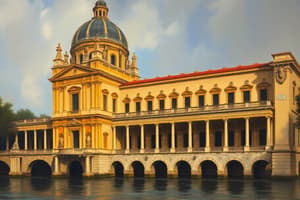Podcast
Questions and Answers
¿En qué año se celebró la primera exposición internacional en Londres?
¿En qué año se celebró la primera exposición internacional en Londres?
1851
¿Qué fue el Crystal Palace?
¿Qué fue el Crystal Palace?
un único pabellón
¿Quién era el arquitecto del Crystal Palace?
¿Quién era el arquitecto del Crystal Palace?
un jardinero
¿Qué representó la exposición internacional de 1851 en Londres?
¿Qué representó la exposición internacional de 1851 en Londres?
¿Qué tipo de exposiciones existían antes de la internacional de 1851?
¿Qué tipo de exposiciones existían antes de la internacional de 1851?
¿Qué elementos se utilizaron en la estructura del palacio Crystal Palace?
¿Qué elementos se utilizaron en la estructura del palacio Crystal Palace?
¿Cuál fue una de las polemicas más comunes relacionada con el palacio Crystal Palace?
¿Cuál fue una de las polemicas más comunes relacionada con el palacio Crystal Palace?
¿Cuál fue la duración de la exposición del Crystal Palace y cuántas personas la visitaron?
¿Cuál fue la duración de la exposición del Crystal Palace y cuántas personas la visitaron?
¿Qué característica inusual tenía el Crystal Palace en comparación con los antiguos palacios?
¿Qué característica inusual tenía el Crystal Palace en comparación con los antiguos palacios?
¿Qué se presentaba en el interior del Crystal Palace que reflejaba la producción industrializada de la época?
¿Qué se presentaba en el interior del Crystal Palace que reflejaba la producción industrializada de la época?
¿Cuál fue el principal conflicto relacionado con la arquitectura del Crystal Palace?
¿Cuál fue el principal conflicto relacionado con la arquitectura del Crystal Palace?
¿Qué característica del Crystal Palace lo hacía diferente de los antiguos palacios?
¿Qué característica del Crystal Palace lo hacía diferente de los antiguos palacios?
¿Qué permitían los materiales utilizados en el Crystal Palace en términos de construcción?
¿Qué permitían los materiales utilizados en el Crystal Palace en términos de construcción?
¿Cuál fue el lugar original del Crystal Palace antes de ser trasladado a Sydenham Hill?
¿Cuál fue el lugar original del Crystal Palace antes de ser trasladado a Sydenham Hill?
¿Qué representaban las exposiciones internacionales en relación con las grandes ciudades como Londres y París?
¿Qué representaban las exposiciones internacionales en relación con las grandes ciudades como Londres y París?
¿Cuál fue la crítica marxista al capitalismo en relación a los objetos expuestos en la exposición universal de París en 1889?
¿Cuál fue la crítica marxista al capitalismo en relación a los objetos expuestos en la exposición universal de París en 1889?
¿Cuál fue la principal razón para la rehabilitación del Campo de Marte en París?
¿Cuál fue la principal razón para la rehabilitación del Campo de Marte en París?
¿Cuál era uno de los propósitos principales de la Torre Eiffel según el texto?
¿Cuál era uno de los propósitos principales de la Torre Eiffel según el texto?
¿Cuál fue el enfoque principal del arquitecto Viollet le Duc durante el siglo XIX según el texto?
¿Cuál fue el enfoque principal del arquitecto Viollet le Duc durante el siglo XIX según el texto?
¿Cuál fue uno de los principales desafíos planteados por la arquitectura moderna según el texto?
¿Cuál fue uno de los principales desafíos planteados por la arquitectura moderna según el texto?
Flashcards
The Great Exhibition of 1851
The Great Exhibition of 1851
The first international exhibition, held in London in 1851, showcasing products from various countries, reflecting a growing ambition for international trade and showcasing industrial advancements.
The Crystal Palace
The Crystal Palace
A monumental glass and iron structure built in London for the 1851 Great Exhibition, characterized by its innovative design and use of new materials.
Joseph Paxton, the Crystal Palace Architect
Joseph Paxton, the Crystal Palace Architect
The Crystal Palace, a revolutionary structure for its time, was designed by Joseph Paxton, a gardener with no formal architectural training, showcasing the innovative use of new materials and construction techniques.
The Crystal Palace as a Mobile Structure
The Crystal Palace as a Mobile Structure
Signup and view all the flashcards
The Technological Advancements at the Crystal Palace
The Technological Advancements at the Crystal Palace
Signup and view all the flashcards
The Controversy Surrounding the Crystal Palace's Materials
The Controversy Surrounding the Crystal Palace's Materials
Signup and view all the flashcards
The Crystal Palace as a Visionary Design
The Crystal Palace as a Visionary Design
Signup and view all the flashcards
The Flexibility of the Crystal Palace's Materials
The Flexibility of the Crystal Palace's Materials
Signup and view all the flashcards
International Exhibitions and Urban Transformation
International Exhibitions and Urban Transformation
Signup and view all the flashcards
Marxist Critique of Capitalism at the Universal Exhibition of Paris 1889
Marxist Critique of Capitalism at the Universal Exhibition of Paris 1889
Signup and view all the flashcards
The Rehabilitation of Champ de Mars in Paris
The Rehabilitation of Champ de Mars in Paris
Signup and view all the flashcards
The Eiffel Tower as a Viewpoint
The Eiffel Tower as a Viewpoint
Signup and view all the flashcards
Viollet-le-Duc's Approach to Architecture
Viollet-le-Duc's Approach to Architecture
Signup and view all the flashcards
The Challenges of Modern Architecture
The Challenges of Modern Architecture
Signup and view all the flashcards
The Crystal Palace as a Symbol of Technological Advancement
The Crystal Palace as a Symbol of Technological Advancement
Signup and view all the flashcards
The Great Exhibition as a Catalyst for Global Collaboration
The Great Exhibition as a Catalyst for Global Collaboration
Signup and view all the flashcards
The Crystal Palace as a Reflection of a Transforming Society
The Crystal Palace as a Reflection of a Transforming Society
Signup and view all the flashcards
The Crystal Palace as a Symbol of Optimism and Progress
The Crystal Palace as a Symbol of Optimism and Progress
Signup and view all the flashcards




